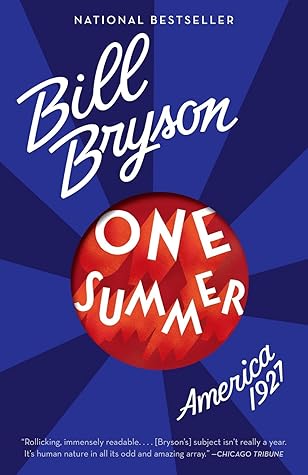More on this book
Community
Kindle Notes & Highlights
As always where killing is involved, technological progress was swift,
Had the purpose of the exercise been to show how unready for ocean flights airplanes were, it could not have been more successful.
The 1920s was a great time for reading altogether—very possibly the peak decade for reading in American life. Soon it would be overtaken by the passive distractions of radio, but for the moment reading remained most people’s principal method for filling idle time.
alcohol is used for all kinds of things besides drinking. It was (and in many cases still remains) an essential ingredient in paint thinners, antifreezes, lotions, antiseptics, embalming fluid, and much more. Thus, it was necessary to allow its continued production for legitimate purposes. Inevitably, some of that still-legal alcohol (actually a great deal: sixty million gallons a year, by one estimate) was diverted into the bootleg trade. To render industrial alcohol disagreeable for drinking, the government took to denaturing it—that is, dosing it with poisons such as strychnine and mercury,
...more
11,700 people died in 1927 alone from imbibing drink poisoned by the government.
The economic cost to the nation was enormous. The federal government lost $500 million a year in liquor taxes—nearly a tenth of national income.
In Chicago, where some twenty thousand saloons remained in business, bars in some neighborhoods operated openly and didn’t pretend to be anything else. In New York, the number of drinking establishments was put at thirty-two thousand, double the pre-Prohibition total.
In Chicago, a municipal chemist tipped some bootleg whiskey down a sink and watched in astonishment as it sizzlingly ate through the porcelain. Curious to know what exactly was in bootleg whiskey, the New York Telegram employed a chemist to test 341 samples brought from city speakeasies. Among the ingredients he isolated were kerosene, nicotine, benzene, benzol, formaldehyde, iodine, sulphuric acid, and soap. About one in six samples, he found, posed a serious threat to health.
Many of those who had supported the Prohibition amendment had assumed that beer and unfortified wines would be spared. It was only now that it began to dawn on people just how sweeping—how dismayingly total—Prohibition was going to be. That was perhaps the most remarkable feature of all in the introduction of Prohibition to America—that it took so many people by surprise. As the social historian Frederick Lewis Allen wrote in Only Yesterday: “The country accepted it not only willingly, but almost absent-mindedly.”
Prohibition laws were nearly impossible to enforce in any case because they were so riddled with loopholes. Doctors could legally prescribe whiskey for their patients, and they did so with such enthusiasm that by the late 1920s they were earning $40 million a year from the practice.
Ford, it transpired, did not know much of anything.
One central characteristic of the Model T now generally forgotten is that it was the first car of consequence to put the driver’s seat on the left-hand side. Previously, nearly all manufacturers placed the driver on the outer, curb-side of the car so that an alighting driver could step out onto a grassy verge or dry sidewalk rather than into the mud of an unpaved road. Ford reasoned that this convenience might be better appreciated by the lady of the house, and so arranged seating for her benefit. The arrangement also gave the driver a better view down the road, and made it easier for passing
...more
It was not a good time to be either a radical or an alien in America, and a positively dangerous time to be both. America was in the grip of something known as the Great Red Scare. In 1917 and 1918, Congress had enacted two startlingly restrictive laws, the Espionage Act and the Sedition Act. Together these provided severe penalties for anyone found guilty of displaying almost any kind of disrespect to the American government, including its symbols—the flag, military uniforms, historic documents, or anything else in which was deemed to repose the glory and dignity of the United States of
...more
Crazily, it became riskier to say disloyal things than to do them. A person who refused to obey the draft law could be imprisoned for one year, but a person who urged others to disobey the draft law could be imprisoned for twenty years.
Between 1905 and 1914, ten million people, mostly from southern and eastern Europe, poured into the United States—a country that had only eighty-three million people to begin with. The numbers of immigrants changed the face of urban America utterly. By 1910, immigrants and the children of immigrants made up almost three-quarters of the populations of New York, Chicago, Detroit, Cleveland, and Boston.
Italians who settled in the Deep South were sometimes made to attend black schools. At first, it was by no means clear that they would be allowed to use white drinking fountains and lavatories. Other immigrant groups—Greeks, Turks, Poles, Slavs, Jews of every nation—encountered similar prejudice, of course, and for Asians and America’s own blacks prejudice and restrictions were even more imaginatively cruel, but the Italians were widely regarded as something of a special case—more voluble and temperamental and troublesome than other ethnic groups.


